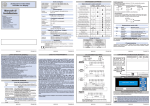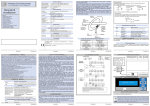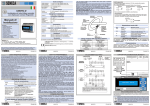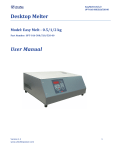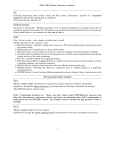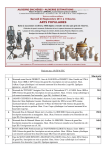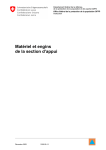Download Installation and Operating Instructions for Automatic Low Voltage
Transcript
Installation and Operating Instructions for Automatic Low Voltage Capacitor Banks Installation and Operating Instructions for Automatic Low Voltage Capacitor Banks 1 2.2.1 Safety Work on and servicing of the capacitor banks may only be performed by specialised electricians. 1.1 Special features of capacitors Terminals of capacitors and connected conductors and equipment within the power factor correction system are to be regarded as live parts even when being switched off (residual charge). 1.2 LV HRC fuses Never use fuse inserts and fuse disconnectors to switch capacitors on or off. 1.3 Current transformers / Power factor controller It is essential to short circuit the secondary side of the current transformer before disconnecting the power factor correction system. This is performed by a short circuiting bridge on terminals K-L on the control terminal strip. 1.4 Assembly and installation Prior to installation, please check that the delivery is complete and free from damages by transport. Do not perform any unauthorised modifications, particularly to the controller and the ventilation system. In case of a later power extension within the same cubicle or enclosure, it might be necessary to add a temperature supervision device as well as ventilation fans. 2.1 Some types of capacitor banks do not contain any overcurrent protection facilities for the capacitor steps. In these cases, use the ratings stated on the type plate for the fuses. Recommendations for the cross sections of the connecting lines can be found in Appendix 2. Please take into account local regulations, local conditions, specifications and any planned increases of compensation power. Ensure that the temperature is as low as possible and that there is sufficient air supply. Maintain the specified ambient temperatures for the system. Note that the system itself increases the ambient temperature. Check before setting up the system that the permissible floor load is not exceeded. The system is to be set up without vibration and fastened in position if necessary. Requirements for connection The rated voltage of the capacitor bank must comply with the rated voltage of the network. Connect the system in accordance with the attached wiring diagram. Incorrect connections are the most frequent reason for commissioning problems. CONDO B017 1004 2.2.2 Measuring connections The current transformer to be used has to be designed for measuring purposes, not for protection purposes. The secondary rated current of the current transformer must comply with the permissible input current of the controller (usually 5A). The cross section of the current transformer connecting lines has to be determined to suit the rated power of the current transformer (see Appendix A3). The additional power consumption of the relevant measuring input on the reactive power controller can be found in the attached description of the controller (app. 2VA for the 5A input of controllers RVC and RVT.). 2.3 Installation site Automatic capacitor banks are suitable for indoor installation and normal operating conditions according to EN 60439, IEC 60439 and VDE 0660 Part 500 (Low voltage switchgear and controlgear assemblies). The following ambient temperatures apply: + 40°C Maximum + 35°C Average over 24 hours - 10°C Minimum 2.2 In special cases, e.g. with reinforced versions of reactors, higher rated fuses are to be used. Details can then be found in the system documentation. Transport Capacitor cubicles with reactors have a high center of gravity and can tip over. Take special care when handling the capacitor bank. Even a slight tilt can cause the cubicles to tip over. When handling by crane, the load on the lifting lugs must be vertical. 2 Power connection Fuses or short circuit current limiting circuit breakers are to be used for overcurrent protection of the connecting lines. These items should generally be selected in such a way that 1,43 times the rated current of the system can be continuously carried. The maximum permissible rated compensation power in relation to the overcurrent protection devices can be found in Appendix A1. Installation The capacitor bank has to be connected in accordance with the circuit diagram supplied. 2.3.1 Measuring connections Never operate current transformers with open terminals. The measuring system of the reactive power controller must determine the reactive power at the measuring point. Its conductors are connected to a current transformer which completely measures the total load to be compensated including the current of the capacitor bank. The side of the current transformer designated “K/P1” must face the feeding side, and the side designated “L/P2” must face the load side. The secondary terminals of the current transformer are designated “k/S1” and “l/S2”. They have to be connected to the terminals of the compensation system with corresponding marking. Install the current transformer in the specified phase in accordance with the wiring diagram and designate this phase “L1/R”. Identify the other phases (“L2/S”) and (“L3/T”) of the network with a rotary field indicator, taking into account that the field rotation has to be clockwise. Condensator Dominit GmbH 1 Installation and Operating Instructions for Automatic Low Voltage Capacitor Banks 2.3.2 Power connections 3.1.1.2 Manual parameter setting of RVC The capacitor bank has to be connected to the network with the correct phases and with a clockwise rotating field. Connect the PE and N conductors or PEN conductor to the terminals provided in the capacitor bank. Press the “Mode”-button until “MAN SET” and the parameter cos ϕ is displayed. Choose the desired value with “+” and “-“ buttons. Press the “Mode”-button twice until the parameter “c/k” is displayed. Calculate and enter the C/k value: Q c or see Appendix A4 C / k = ( 0 .6 . . .0 .7 ) ⋅ U ⋅ The connection between PE and N is necessary in a TN-C system, otherwise it has to be removed. Refit all covers. 2.3.3 Fault signalling system For external use of the alarm signals of the power factor controller there is a pair of terminals (M, M) in the control terminal bar of the capacitor bank. These terminals are connected with a floating contact which is closed if • the desired cos ϕ is not reached (Target cos ϕ for RVC, Alarm cos ϕ for RVT) • A voltage disconnection is present • An alarm threshold is violated (RVC, RVT) • The internal temperature of the controller is above 85°C Please also refer to the controller manual. 3 Commissioning Check the electrical and mechanical connections. Perform a visual check before commissioning the system. • Have all tools been removed? • Have all covers been refitted? 3.1 Setting the reactive power controller and energizing the system To start the commissioning open the short circuit bridges on the CT terminals and the terminals k and l of the control terminal bar. Switch on the overcurrent protection of the Control voltage circuit and energize the capacitor bank. The controller display becomes active. The following procedure depends on the type of controller. The majority of nowadays available power factor controllers provide an automatic self-programming function, please refer to the controller manual. If the automatic programming fails the programming must be made manually. For this procedure please refer to the controller manual. In order to achieve a short commissioning even when manual programming is necessary the controllers are preprogrammed during the factory test except the values for current sensitivity and desired cos ϕ. The switching sequence or switching program should not be changed, as the optimum program has already been set at the factory. Modification may become necessary in exceptional cases only, e.g. when the system is expanded. 3.1.1 Parameter setting of RVC controllers 3.1.1.1 Automatic setup of RVC Press the “Mode”-button twice until “AUTO SET” is displayed. Press “-“ and “+” button simultaneously for 5 seconds. “AU” is flashing and the automatic procedure switches ON and OFF steps several times. After the automatic setup is finished the target cos ϕ must be set to the desired value ( means inductive, means capacitive). Finally the controller must be set back to automatic mode. Push “Mode” button several times until “AUTO” appears. 2 3 ⋅ k Qc U is the smallest capacitor steps power (kvar) is the rated system voltage (kV) at the point of installation of the current transformer k is the ratio of the current transformer, e.g. 100A/5A=20 Set back the controller to automatic mode by pushing “Mode” button several times until “AUTO” appears. 3.1.2 Parameter setting of RVT controllers When an RVT controller is energized for the first time the “Set language” menu is displayed. Choose the desired language with the arrow buttons and confirm with “OK” button. 3.1.2.1 Automatic setup of RVT Choose in the “Welcome” menu “Settings”, then “Change mode” and then “Set”. Press the “OK”-button to confirm, then choose “Commissioning”, then “Automatic” and confirm. After the automatic programming is finished the target cos ϕ must be set. Finally the controller must be set back to automatic mode. Choose “Change mode”, then “Automatic” and confirm.) 3.1.2.2 Manual parameter setting of RVT Choose in the “Welcome” menu “Settings”, then “Change mode” and then “Set”. Confirm with “OK”-button, then choose “Commissioning”, then “Guided” and confirm. Enter the ratio of the current transformer (Iprimary/Isecondary). Confirm the following parameters up to target cos ϕ. Set the target cos ϕ to desired value. Finally the controller must be set back to automatic mode. Choose “Change mode” and confirm “Automatic”.) 3.2 Operation of the bank The switching delay time is set to 40 seconds during factory test or in automatic programming of RVC and RVT automatically. Shortening the switching delay time can lead to damage. The switching time or switching delay time is to be set to minimum 60 seconds for systems in EMV environments classified as “residential areas”. After returning to automatic bank mode: • When correctly connected and when there is a need for compensation, the reactive power controller indicates that it will activate a capacitor step. • The capacitor steps are connected in accordance with the set switching delay time until the specified cosϕ is achieved. Note: Automatic capacitor banks contain discharge facilities which achieve discharge to 10% of rated voltage or less within 40 seconds of a capacitor being switched off. Note: Capacitors must be discharged to at least 10% of rated voltage before reconnection, and therefore: • do not operate contactors manually, • do not reduce the switching delay times, • do not perform any work on the control circuit when it is live. Condensator Dominit GmbH CONDO B017 1004 Installation and Operating Instructions for Automatic Low Voltage Capacitor Banks 3.3 Functional testing 4.2 A functional test of the system and potentially necessary troubleshooting are described in the controller manual. For RVC see chapters “Testing”, “Error messages” and “Troubleshooting”. For RVT see chapters 4.2.5 and A3. Note: Too many steps switched on can lead to overcompensation, i.e. increased voltage, particularly under low load. Not sufficient compensation power switched on can lead to overloading of the feeder, particularly under heavy load. If the system fails the functional test see Chapter 4. 4 Troubleshooting Please observe the notes on safety (Chapter 1) and on discharging of capacitors (Chapter 3.1). 4.1 Reactive power controller Refer to the controller manual. For RVC see chapters “Testing”, “Error messages” and “Troubleshooting”. For RVT see chapters 4.2.5 and A3. Common problems and possible reasons: a) The reactive power controller signals a fault and demands more compensation power. b) The reactive power controller signals a fault and wants to switch off capacitor steps. c) The reactive power controller does not switch steps on or off although there are different loads, or it does not appear to switch correctly. • Is the capacitor bank connected as specified in the wiring diagram? Have any subsequent modifications been performed at site? See also Chapters 2.3.1 and 2.3.2. • Is the cosϕ setpoint correct? • Is the expected current transformer current flowing? • Have fuses for the control/measuring current tripped? • Has a fuse in the feeder or for the capacitor steps tripped? • Are the capacitor contactors in the specified switching positions? Fault signals can be acknowledged and cleared. For a), also clarify the following: • Is there a significant loss of capacitance in any capacitor step? For b), also clarify the following: • Are there further capacitors in the system? For c), also clarify the following: • Has the switching delay time or zero voltage blocking time (approx. 90 s) already expired? • Is the reactive power controller set to automatic mode? • Are controller parameters set correctly (see chapter 3.1)? d) In spite of relatively constant inductive load, the system switches relatively often. • Are controller parameters set correctly (see chapter 3.1)? e) A fault is signalled although the system is functioning perfectly. • A temporary but high reactive power demand may have led to a fault signal. The fault signal can be acknowledged and cleared. f) The reactive power controller indicates that steps are switched on, but the relevant contactors have not switched. • Check the wiring between contactors and controller. g) An alarm is indicated. Refer to the controller manual. For RVC see chapter “Alarm and protection”. For RVT see chapters 4.2.3.2. (Protections), 4.2.3.4. (Alarm) and 4.3. (Alarm logging). CONDO B017 1004 Other observations a) Overcurrent protection systems (fuses) for capacitor steps trip. • Are fuses with the correct rated current fitted? • Are the discharge devices okay? • Is the switching delay time of the reactive power controller set correctly? • Is there a short circuit or short circuit to the enclosure? Do the contactors occasionally “chatter”? b) Contactors are not working. • Are the contactor coils damaged? • Have the corresponding fuses tripped? See also the items under a) c) Capacitor breakdown. • Have there been unusual or new load or network situations in the recent period? • Have the conditions for heat dissipation of the capacitor bank or from the point of installation been fundamentally changed? • Is the reactive power controller working correctly? See also the items under a) and b). 5 Maintenance recommendations Your capacitor bank is an investment whose function you can monitor and ensure by regular maintenance. If you cannot perform the recommended maintenance work yourself, our sales offices will be pleased to provide assistance. Please observe the notes on safety (Chapter 1) and on discharging capacitors (Chapter 3.1). 5.1 Contacts Defective contacts in capacitor circuits can cause sparkling whose high frequency oscillations overload the capacitors. It is therefore recommended that all contacts (fuses, screw and plug connections, terminals) in capacitor banks be checked during inspection and fastened if found to be vibrating. When the switching frequency is extremely high, also check the switching contacts in the capacitor contactors. 5.2 Air supply The air intake and outlet openings and any filter tissues are to be checked for contamination and cleaned if necessary. In capacitor banks with fans, check the function and control of fans regularly. 5.3 Discharge devices Defective discharge systems can lead to impermissible loads for almost all the equipment in the capacitor bank. It is therefore advisable to check their function during inspections. The amount of work required is not much: • Switch the capacitor step on. • Switch the capacitor step off. • After at least 40 seconds measure the voltage between all the capacitor terminals on the relevant contactor: When the discharge device is functioning correctly, a residual (DC) voltage of less 0.1 x rated voltage is measured. If the discharge system is defective, a residual (DC) voltage of >>0.1 x rated voltage, which can be over 1 kV in extreme cases, may be measured. 5.4 Control function Performance of a functional test as set out in Chapter 3.2 is recommended to verify the control function of the compensation system. Condensator Dominit GmbH 3 Installation and Operating Instructions for Automatic Low Voltage Capacitor Banks Appendix A1 Maximum permissible rated compensation power for 400 V, 3-phase in relation to external fuses Fuse LV HRC A 16 20 25 35 50 63 80 100 125 160 200 250 315 400 500 630 800 without reactor or (LA) (LB) max. kvar 7,6 9,7 11,7 16,7 24,2 30,0 39 48 60 78 100 125 158 200 250 315 400 with reactor L057 max. kvar 8,3 10,3 12,5 17,3 25,2 31,7 40 50 63 81 104 130 164 208 260 328 416 with reactor L070 max. kvar 9,0 11,0 14,0 19,4 27,7 34,5 44 55 68 88 113 141 178 226 283 356 452 with reactor L125 max. kvar 9,0 11,1 14,0 20,0 28,4 35,7 45 57 71 91 117 146 185 234 293 369 469 with reactor L140 max. kvar 9,0 11,1 14,0 20,0 28,4 35,7 45 57 71 91 117 146 185 234 293 369 469 with reactor LL1 max. kvar 9,0 11,0 14,0 19,4 27,7 34,5 44 55 68 88 113 141 178 226 283 356 452 with reactor LL2 max.kvar 8,3 10,3 13,2 18,0 25,6 32,5 41 52 65 83 107 133 168 213 267 336 426 For other rated voltages: 230 V: Values / 1,73; 525 V: Values / 0,76; 690 V: Values / 0,58. Appendix A2 Extract from DIN VDE 0100. Fuse LV HRC A 16 25 35 50 63 80 100 125 160 200 250 315 400 500 630 800 Appendix A3 Losses in Cu-conductors Terminal cross section mm² Length 4 x 2,5 4x4 4x6 4 x 10 4 x 16 3 x 25/16 3 x 35/16 3 x 50/25 3 x 70/35 3 x 95/50 3 x 120/70 3 x 185/95 2 || 3 x 95/50 2 || 3 x 120/70 2 || 3 x 185/95 2 || 3 x 240/120 5m 10m 15m 20m 30m 40m 50m 60m 80m 100m 120m 150m 200m 250m 300m 500m Losses [W] for 5 A for 1 A with cross section with cross section 1,5mm² 2,5mm² 4,0mm² 1,5mm² 2,5mm² 4,0mm² 2,9 1,8 1,1 0,1 0,1 0,0 5,8 3,5 2,2 0,2 0,1 0,1 8,8 5,3 3,3 0,4 0,2 0,1 11,7 7,0 4,4 0,5 0,3 0,2 17,5 10,5 6,6 0,7 0,4 0,3 23,3 14,0 8,8 0,9 0,6 0,4 29,2 17,5 10,9 1,2 0,7 0,4 35,0 21,0 13,1 1,4 0,8 0,5 46,7 28,0 17,5 1,9 1,1 0,7 35,0 21,9 2,3 1,4 0,9 42,0 26,3 2,8 1,7 1,1 32,8 3,5 2,1 1,3 43,8 4,7 2,8 1,8 5,8 3,5 2,2 7,0 4,2 2,6 11,7 7,0 4,4 Appendix A4:C/k value settings on the reactive power controller Current transformer A 50/5 100/5 150/5 200/5 300/5 400/5 500/5 600/5 800/5 1000/5 1500/5 2000/5 2500/5 3000/5 Current transformer ratio k 10 20 30 40 60 80 100 120 160 200 300 400 500 600 C/k values for 400 V, 3-phase 2,5 0,25 0,13 0,08 0,06 3,3 0,33 0,17 0,11 0,08 0,06 5 0,50 0,25 0,17 0,13 0,08 0,06 0,05 6,7 0,67 0,34 0,22 0,17 0,11 0,08 0,07 0,06 8,3 10 0,42 0,28 0,21 0,14 0,10 0,08 0,07 0,05 0,50 0,33 0,25 0,17 0,13 0,10 0,08 0,06 0,05 smallest capacitor step power in kvar 12,5 15 16,7 20 25 0,63 0,42 0,31 0,21 0,16 0,13 0,10 0,08 0,06 0,75 0,50 0,38 0,25 0,19 0,15 0,13 0,09 0,08 0,05 0,56 0,42 0,28 0,21 0,17 0,14 0,10 0,08 0,06 0,67 0,50 0,33 0,25 0,20 0,17 0,13 0,10 0,07 0,05 0,63 0,42 0,31 0,25 0,21 0,16 0,13 0,08 0,06 0,05 30 33,3 40 50 60 100 0,75 0,50 0,38 0,30 0,25 0,19 0,15 0,10 0,08 0,06 0,05 0,56 0,42 0,33 0,28 0,21 0,17 0,11 0,08 0,07 0,06 0,67 0,50 0,40 0,33 0,25 0,20 0,13 0,10 0,08 0,07 0,63 0,50 0,42 0,31 0,25 0,17 0,13 0,10 0,08 0,75 0,60 0,50 0,38 0,30 0,20 0,15 0,12 0,10 0,63 0,50 0,33 0,25 0,20 0,17 For other rated voltages: 230 V: Values x 1,73; 525 V: Values x 0,76; 690 V: Values x 0,58. Condensator Dominit GmbH An der Bremecke 8 . D-59929 Brilon Tel.: +49 (0)2961 / 782-0 Fax. +49 (0)2961 / 782-36 www.condensator-dominit.de [email protected] CONDO B017 1004 4





